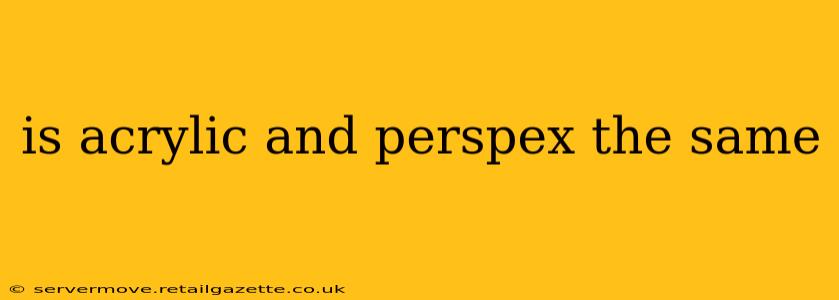Is Acrylic and Perspex the Same? Unveiling the Truth About These Similar Materials
The terms "acrylic" and "Perspex" are often used interchangeably, leading to confusion. While closely related, they aren't exactly the same. This article will clarify the relationship between acrylic and Perspex, exploring their similarities and key differences.
What is Acrylic?
Acrylic is a generic term referring to a family of thermoplastic polymers. These polymers are known for their transparency, durability, and versatility. They are created through a polymerization process involving acrylic monomers, resulting in a material that's lightweight yet strong. Acrylic's wide range of applications stems from its ability to be molded, cast, and extruded into various shapes and thicknesses.
What is Perspex?
Perspex is a brand name, specifically a trademark of Lucite International, for a type of polymethyl methacrylate (PMMA) acrylic sheet. Think of it like Kleenex and facial tissues – Kleenex is a brand name for a specific type of tissue, while "tissue" is the broader category. Perspex, therefore, is a high-quality, branded version of acrylic sheet.
So, are Acrylic and Perspex the same?
The short answer is no, but it's a nuanced "no." All Perspex is acrylic, but not all acrylic is Perspex. Perspex represents a specific high-quality grade of acrylic sheet, known for its superior clarity, impact resistance, and overall performance characteristics. Many other manufacturers produce acrylic sheets, some of which may offer comparable qualities, but they are not technically "Perspex."
What are the Key Differences?
While both materials are essentially PMMA, the differences lie primarily in:
- Manufacturing and Quality Control: Perspex undergoes rigorous quality control measures throughout its manufacturing process, ensuring consistent quality and performance. Other acrylic brands may vary in their manufacturing processes and resulting quality.
- Branding and Reputation: Perspex benefits from decades of established branding and reputation for high-quality acrylic products. This strong brand recognition often translates into a premium price point.
- Specific Applications: Due to its superior quality, Perspex might be preferred for demanding applications requiring exceptional clarity, weather resistance, or impact strength. This could include high-end displays, architectural elements, or specialized optical components.
What are the common applications of acrylic and Perspex?
Both acrylic and Perspex find applications in a wide variety of industries and products, including:
- Signage: Their clarity and durability make them ideal for indoor and outdoor signage.
- Displays: Museums, shops, and galleries use acrylic and Perspex for protective display cases and showcases.
- Lighting: Acrylic's light-transmission properties are utilized in lighting fixtures and diffusers.
- Automotive: Acrylic is employed in car interiors, instrument panels, and lighting components.
- Architectural Applications: Large sheets of acrylic are used as cladding, glazing, and structural elements in buildings.
Is Perspex more expensive than other acrylics?
Yes, generally speaking, Perspex tends to be more expensive than other brands of acrylic sheets. This is due to its reputation for quality, rigorous manufacturing standards, and the associated branding costs.
Which should I choose – Acrylic or Perspex?
The best choice depends on your specific needs and budget. If you require the highest quality, consistent performance, and a reputable brand name, Perspex is a reliable choice. However, for less demanding applications where cost is a major factor, other acrylic brands can be a suitable alternative. It's crucial to carefully consider the application requirements before making a decision.
This comprehensive guide should clear up any confusion between acrylic and Perspex. Remember, Perspex is a specific brand of high-quality acrylic, not a separate material altogether. Understanding this distinction will help you make informed decisions when selecting the right material for your project.
